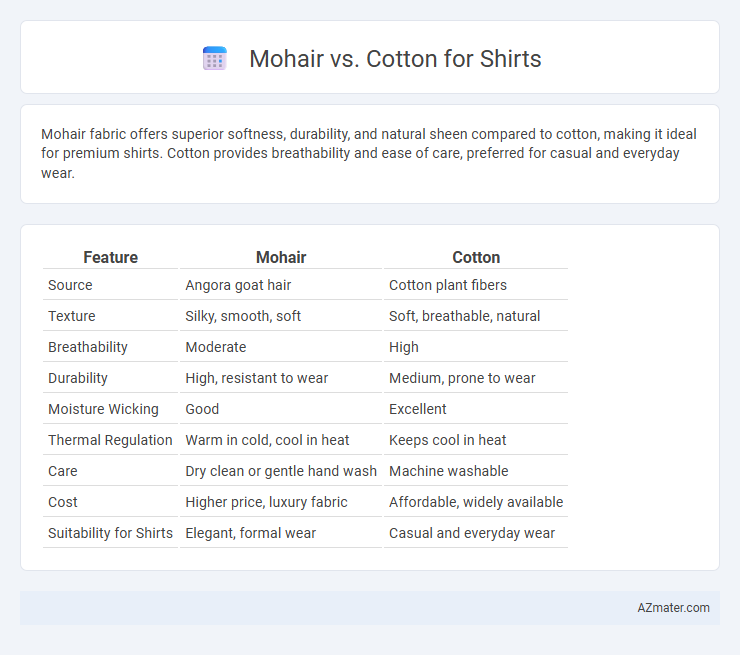Mohair fabric offers superior softness, durability, and natural sheen compared to cotton, making it ideal for premium shirts. Cotton provides breathability and ease of care, preferred for casual and everyday wear.
Table of Comparison
| Feature | Mohair | Cotton |
|---|---|---|
| Source | Angora goat hair | Cotton plant fibers |
| Texture | Silky, smooth, soft | Soft, breathable, natural |
| Breathability | Moderate | High |
| Durability | High, resistant to wear | Medium, prone to wear |
| Moisture Wicking | Good | Excellent |
| Thermal Regulation | Warm in cold, cool in heat | Keeps cool in heat |
| Care | Dry clean or gentle hand wash | Machine washable |
| Cost | Higher price, luxury fabric | Affordable, widely available |
| Suitability for Shirts | Elegant, formal wear | Casual and everyday wear |
Introduction to Mohair and Cotton
Mohair, derived from the Angora goat, is prized for its silky texture, durability, and natural sheen, making it a luxury fabric for shirts with excellent breathability and wrinkle resistance. Cotton, sourced from the cotton plant, is a widely used natural fiber known for its softness, comfort, moisture absorption, and versatility across various shirt styles. Comparing mohair and cotton highlights key differences in fiber origin, fabric texture, breathability, and maintenance requirements.
Key Properties of Mohair Fabric
Mohair fabric, derived from the Angora goat, offers exceptional strength, sheen, and natural elasticity, making it more durable and wrinkle-resistant than cotton. Its moisture-wicking properties and breathability ensure superior comfort in warm climates, while the smooth fiber surface enhances softness and luster. Compared to cotton, mohair provides better insulation and a luxurious appearance, ideal for high-end shirts requiring both style and performance.
Key Properties of Cotton Fabric
Cotton fabric is renowned for its breathability, softness, and natural moisture-wicking properties, making it comfortable for shirts in warm weather. It offers high durability and easy care, with resistance to pilling and shrinking when properly maintained. Cotton's hypoallergenic nature and versatility in weaving styles contribute to its widespread use in casual and formal shirts.
Comfort and Breathability Comparison
Mohair excels in moisture-wicking and temperature regulation, making it highly breathable and comfortable for shirts in varying climates. Cotton offers softness and natural breathability but tends to retain moisture, which can reduce comfort in hot, humid conditions. The superior airflow and lightweight nature of mohair provide enhanced comfort compared to cotton, especially during prolonged wear.
Durability and Longevity
Mohair fibers, derived from the Angora goat, exhibit exceptional durability due to their natural strength and resistance to wear, making mohair shirts long-lasting compared to cotton alternatives. On the other hand, cotton, a cellulose-based fiber from the cotton plant, offers moderate durability but tends to weaken and wear out faster with frequent washing and extended use. Mohair's ability to maintain fabric integrity and resist pilling enhances its longevity, positioning it as a superior choice for durable shirts in comparison to the more common cotton fabric.
Moisture Absorption and Wicking
Mohair fibers excel in moisture absorption and wicking, quickly drawing sweat away from the skin to keep the wearer dry and comfortable. Cotton, known for its natural absorbency, soaks up moisture but tends to retain it longer, which can lead to a damp feeling during extended wear. The superior breathability and moisture management properties of mohair make it an ideal choice for shirts in active or warm conditions.
Allergenicity and Skin Sensitivity
Mohair fibers are naturally hypoallergenic, reducing the risk of irritation for sensitive skin compared to cotton, which can sometimes trap allergens and cause discomfort. Cotton is breathable and soft but may retain allergens like dust mites and pollen, potentially aggravating skin sensitivities. Choosing mohair for shirts can benefit individuals prone to allergic reactions or dermatitis due to its smooth texture and moisture-wicking properties.
Environmental Impact
Mohair production has a lower environmental footprint than cotton due to its natural biodegradability and minimal water requirements. Cotton cultivation typically demands extensive water usage and heavy pesticide application, contributing to soil degradation and water pollution. Choosing mohair shirts supports sustainable fashion by reducing resource consumption and promoting eco-friendly fiber sourcing.
Price and Availability
Mohair shirts tend to be more expensive than cotton due to the luxury status and limited supply of angora goat fibers, with prices often doubling or tripling compared to standard cotton shirts. Cotton is widely available globally, benefiting from extensive cultivation and mass production, making it more affordable and accessible in various retail outlets. While mohair offers unique sheen and durability, strict sourcing and seasonal harvesting affect its availability, contrasting with the consistent year-round supply of cotton fabric.
Final Verdict: Which Fabric is Best for Shirts?
Mohair offers superior breathability, natural sheen, and moisture-wicking properties, making it ideal for lightweight, luxurious shirts suited to warm climates. Cotton provides excellent softness, durability, and easy care, making it a versatile and cost-effective choice for everyday wear. For premium comfort and elegance in shirts, mohair is best, while cotton remains the top fabric for practicality and affordability.

Infographic: Mohair vs Cotton for Shirt
 azmater.com
azmater.com